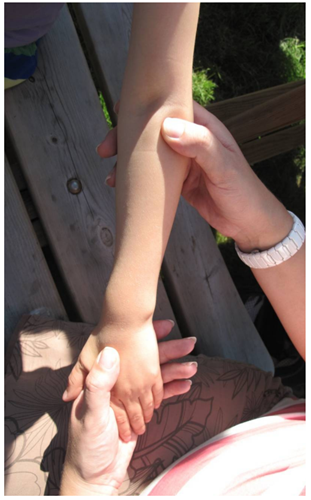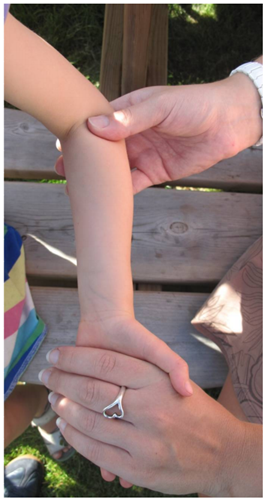Pulled elbow
exp date isn't null, but text field is
Objectives
This guideline describes how to assess and manipulate a pulled elbow in children.
Scope
Children presenting to the Emergency Department with a pulled elbow.
Audience
Emergency department staff at RHC.
Pulled elbow is a common childhood injury in under fives. Emergency Departments treat on average five cases per week.1 There is predominance in girls and the left side. Longitudinal traction of the child’s forearm results in a pulled elbow. This pulls the radial head through the annular ligament causing traumatic subluxation of the radial head.
Pulled elbow is usually caused by an adult pulling on the child’s arm or pulling on the forearm of a resisting child. However in 50% there may be no history of a pull on the child’s arm.2 This is often because the event was unwitnessed. The child may find localising the pain difficult and even complain of wrist pain.
There should be a sudden loss of function in the affected arm. The child holds the forearm in slight flexion with pronation. During examination the child often allows flexion and extension but will find supination and pronation painful. On examination there should be no joint swelling, bruising, warmth or erythema.
This should be a diagnosis concluded from history, presentation and subsequent successful manipulation. An elbow x-ray is not routinely required and is usually normal.
After simple analgesia the pulled elbow should be manipulated. The majority will only need a single manipulation.3
There are two common manipulation techniques.
- One hand should be placed over the radial head in order to palpate a click, sometimes felt on successful reduction. The technique involves extending the child’s forearm and pronating (child’s palm downwards). See image below.
- The alternative technique involves the child’s forearm being supinated (child’s palm upwards) followed by flexion. See image below.
The pronation technique is more successful and less painful.4,5
The child should be reviewed 15 minutes after attempted reduction, they will often be happily using the arm and can be safely discharged with parental advice to avoid lifting or pulling the child by the arm.
Parents should also be advised a pulled elbow can be recurrent in 5% of cases; this risk lessens as the child gets older and the annular ligament tightens. Given the low recurrence rate there is no benefit in splinting pulled elbows post manipulation.6
If the child is still not using the arm, manipulation should be repeated using the alternative technique. X-ray should be requested if the child will not use the affected arm 15 minutes after repeat attempt at manipulation.
Occasionally the child may not be using the arm on review but the reduction felt successful. In cases where the injury is greater than 12 hours old the child may take 1-2 days to use the arm again.7 In this case the child can be discharged, with a broad arm sling and Emergency Department review in 48 hours.
|
1. Pronation technique |
2. Supination technique |
* X-ray of radial head subluxation may be normal or may show increased radio-coronoid distance on the lateral x-ray. The radiocapitellar line may be displaced by more than 3mm. The radiographer may have reduced the pulled elbow when supinating the elbow for the AP film.

* X-ray of radial head subluxation may be normal or may show increased radio-coronoid distance on the lateral x-ray. 8 The radiocapitellar line may be displaced by more than 3mm. 9 The radiographer may have reduced the pulled elbow when supinating the elbow for the AP film.
- Jongschaap HC, Youngson GG, Beattie TF. The epidemiology of radial head subluxation ("pulled elbow") in the Aberdeen city area. Health Bull 1990;48:58-1.
- Staheli LT. Trauma/management in primary care. In: Fundamentals of pediatric orthopedics. Philadelphia: Lippincott, Williams and Wilkins; 2008.
- von Laer L. Elbow injuries. In: Pediatric fractures and dislocations. New York: Thieme; 2004;p. 122–210.
- Krul M, van der Wouden JC, van Suijlekom-Smit LWA et al. Manipulative interventions for reducing pulled elbow in young children. Cochrane Database of Systematic Reviews 2009, Issue 4. Art. No.: CD007759.
- Lewis, D. Reduction of pulled elbows. BestBets Best Evidence Topics, 2003.
- Ellis, G. Treatment of recurrent pulled elbows. BestBets Best Evidence Topics, 2008.
- Smith BS, Crelin D. Paediatric elbow injuries: Part 1: Assessing the elbow, identifying and managing a pulled elbow. AENJ 2011; 14:115-119.
- Scapinelli R, Borgo A. Pulled elbow in infancy: diagnostic role of imaging. Radiol Med 2005; 10:655–664.
- Snyder HS. Radiographic changes with radial head subluxation in children. J Emerg Med 1990; 8(3):265.
Last reviewed: 28 November 2017
Next review: 31 October 2025
Author(s): Steve Foster
Version: 3
Approved By: Clinical Effectiveness



